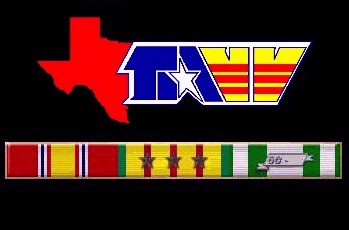UA: Unauthorized absence. (See "AWOL")
UH-1H: A Huey helicopter
UNBLOUSED: Pants not tucked into boot tops.
UNIFORM: Military phonetic for the letter 'U'.
US: Prefix to serial number of Army draftees
USA: United States Army, United States of America.
USAF: United States Air Force.
USAID: U.S. Agency for International Development.
USARPAC: United States Army, Pacific.
USARV: United States Army, Vietnam.
USCG: Unites States Coast Guard.
USMC: United States Marine Corps.
USN: United States Navy.
USO: United Service Organization. Provided entertainment to the troops, and was intended to raise morale.
USOM: U.S. Operations Mission. Funded U.S. programs during the early American involvement in Vietnam.
VA: Veterans Administration.
VC: Viet Cong, the National Liberation Front
VCI: Viet Cong infrastructure. It was the aim of the Viet Cong to have a complete government in place when their victory was finally won. Thus, where manpower allowed, Communist cadres were secretly assigned positions as village chiefs, police officers, postment, District-level officers, Province-level officers, and National-level officers. The VCI were the "shadow government" of the National Liberation Front and were awaiting the day they could step forward and claim their offices.
VELOCITY: The speed of the bullet after firing and the tumbling action of the bullet contributed to its effectiveness. The combination of these effects plus its rapid-fire capability meant that accuracy was not a major requirement, thus reducing the training time before a soldier could be sent into combat. Most armaments analysts judge the AK-47, which normally holds thirty bullets, to be superior to the U.S. M-16, which became the standard weapon of American, Korean, and South Vietnamese troops. It was more durable and less adversely affected by the climate and conditions of Vietnam. There are a number of accounts of cases in which American troops.
VFW: Veterans of Foreign Wars.
VHPA: Vietnam Helicopter Pilots Association.
VICTOR CHARLIE: the Viet Cong; the enemy.
VICTOR: Military phonetic for the letter 'V'.
VIET CONG: The Communist-led forces fighting the South Vietnamese government. The political wing was known as the National Liberation Front, and the military was called the People's Liberation Armed Forces. Both the NLF and the PLAF were directed by the People's Revolutionary Party (PRP), the southern branch of the Vietnamese Communist Party, which received direction from Hanoi through COSVN, which was located in III Corps on the Cambodian border. After 1968, as negotiations began in Paris, the NLF established the Provisional Revolutionary Government.
VIET MINH: Viet Nam Doc Lap Dong Minh Hoi or the Vietnamese Independence
VIET MINH: Viet Nam Doc Lap Dong Minh Hoi, or the Vietnamese Allied Independence League. A political and resistance organization established by Ho Chi Minh before the end of World War II, dominated by the Communist Party. Though at first smaller and less famous than the non-Communist nationalist movements, the Viet Minh siezed power through superior organization skill, ruthless tactics, and popular support.
VIETNAMESE POPULAR FORCES: South Vietnamese local military forces.
VIETNAMIZATION: U.S. policy initiated by President Richard Nixon late in the war to turn over the fighting to the South Vietnamese Army during the phased withdrawal of American troops. The term was coined by Nixon's Secretary of Defense, Melvin Laird to replace the policy of "de-Americanization" first enunciated by Nixon on June 8, 1969.
VILLE (VILL): Ostensibly "village" but used to refer to any group of hooches.
VN: Vietnam.
VNAF: South Vietnamese Air Force.
VNQDD: Viet Nam Quoc Dan Dang, or Nationalist Party of Vietnam. A non-Communist movement formed in 1926, based on the doctrines of Sun Yat-sen. The VNQDD conducted the Yen Bai uprising in 1930, which began the modern struggle for Vietnamese independence. During World War II the VNQDD staged in southern China and were instrumental in gaining Ho Chi Minh's release from a Chinese prison to help with the resistance fight against the Japanese. Ho later broke with the VNQDD. By 1950, having lost their bases in southern China when Mao came to power, the VNQDD ceased to exist as an effective organization.
VSI: Very seriously ill. Army designation for those troopers who may die without immediate and definitive medical care.
VT: Variable Time artillery fuze, incorporated a small radar transceiver, used to obtain a reliable 20 meter airburst.
